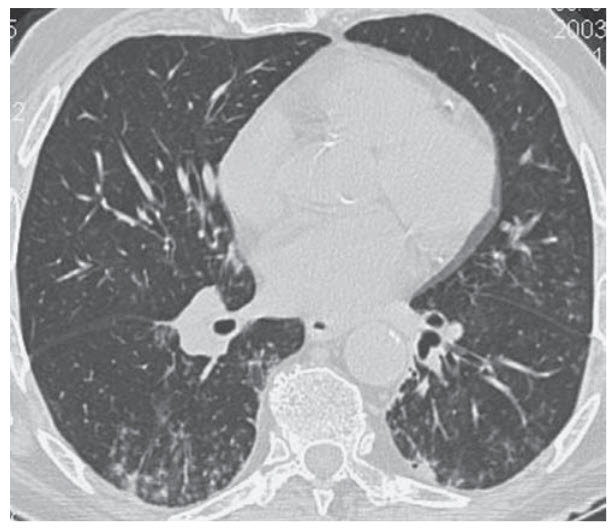Question 59#
A 73-year-old nursing home resident complains of severe difficulty breathing. The nursing home staff reports that she has had several episodes of pneumonia since she has been there and is often delirious during the night. She has a history of hypertension, diabetes, dementia, and chronic cough with daily sputum production. Her medications include metformin, hydrochlorothiazide, over-the-counter cough suppressants, and haloperidol as needed. She has a 10 packyear smoking history and quit 30 years ago. She has a temperature of 38.3°C, blood pressure of 104/62 mmHg, heart rate of 91 beats per minute, respiratory rate of 26 breaths per minute, and oxygen saturation of 94% on room air. The patient’s CT scan is shown below (Figure below).

Which of the following is the most likely cause of this patient’s lung findings?
A. Smoking historyB. Infection with Pseudomonas
C. Recurrent aspiration events
D. Antibodies against type IV collagen
Correct Answer is C
Comment:
Recurrent aspiration events. Bronchiectasis is a destructive process of the airways caused by recurrent infections without the ability to adequately respond to the infections. The inadequate response may be caused by processes such as airway obstruction, immunosuppression, or impaired drainage from the site of infection. Bronchiectasis may present similarly to COPD with a chronic cough, daily sputum production, wheezing, and dyspnea. It is also a common cause of hemoptysis. This patient’s CT confirms the diagnosis of bronchiectasis and shows enlarged airways predominantly in the lower lobes, which is likely the result of recurrent aspiration pneumonias (risk factors in this patient are old age and dementia). Other causes of bronchiectasis include cystic fibrosis, obstructions (COPD, lung tumor, mucus plugging), allergic bronchopulmonary aspergillosis, and immunosuppression. (A) A history of smoking may lead the reader to suspect COPD; however, the CT scan does not fit this diagnosis. In COPD, there is typically bronchial wall thickening from chronic bronchitis and alveolar septal destruction with enlargement of airspaces from emphysema. (B) Recurrent pseudomonal infections are a complication of bronchiectasis, and are unlikely to be the cause of bronchiectasis in this patient. Culture of her sputum would likely show mixed flora containing anaerobes since her pneumonia is caused by aspiration events. (D) Goodpasture syndrome is an autoimmune disease that affects the lungs and the kidneys and may present with hemoptysis and nephritic syndrome, which are not seen in this patient.